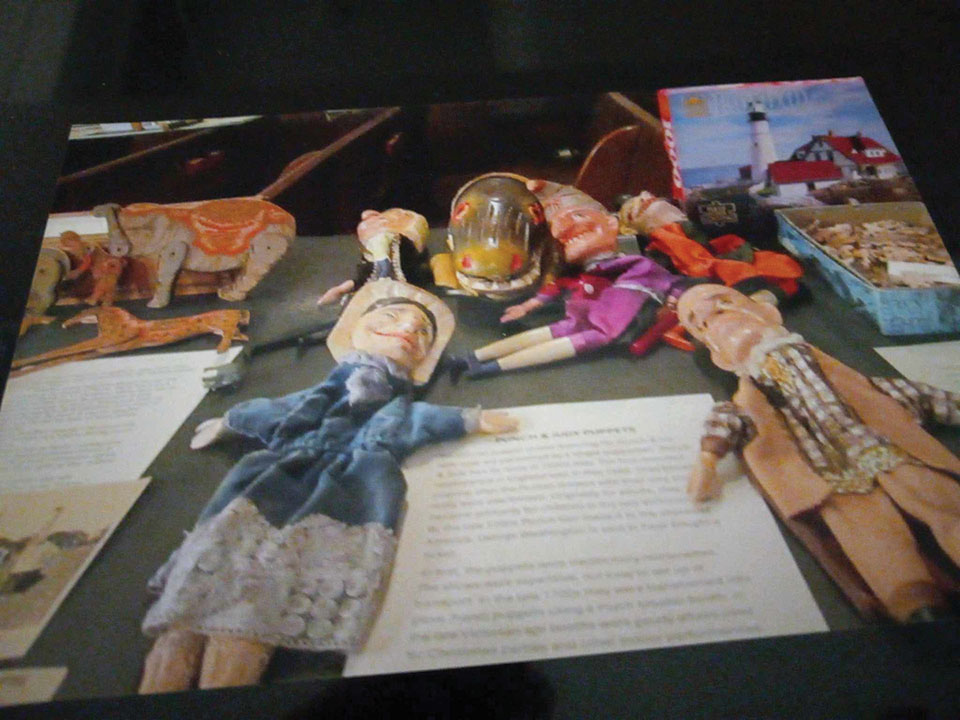My grandparents’ house on Snipatuit Rd. (one of Rochester’s older houses) was a rambling structure with an added-on addition and an upstairs with two bedrooms and several attics. When we visited on school vacations, there was often something interesting retrieved from an attic that we could play with.
A short aside, my grandmother, Marion Hartley, taught school for many years and she was always happy to have my sister, brother and myself spend spend school vacations with her on her school vacations. I think that used to be called a “busman’s holiday”.
Now back to the attics and their contents. I was reminded of the marionettes and stage that she had stored in one by the Punch and Judy set that is now in our current exhibit at the Rochester Historical Museum. The set pictured here is on loan from the Mattapoisett Historical Museum and has more characters than the one of my childhood. The picture shows Punch. He’s the one dressed as a jester. Then there is Judy, a clown, a crocodile, and either the doctor or the lawyer. The set we played with had Punch, Judy, a baby and maybe a policeman. To be honest, I found both Punch and Judy to be kind of creepy.
Punch and Judy go way back, but puppet shows go back even further. Herodotus, a Greek historian, wrote about figures operated by strings (marionettes) as far back as the 5th century B.C. Another Greek historian, Xenophon of Athens, mentions a traveling puppet show. In Italy, theaters as early as the 16th century, had puppet shows that used comedy to make fun of authority figures and life’s injustices.
Punch and Judy appeared in England for the first time in 1662. After years of Puritan control, Britain was primed for the puppet show’s outrageous comedy. A traditional Punch and Judy show had Mr. Punch and his wife Judy in a series of scenes where the two interacted, often ending with someone the victim of a “slapstick”. These shows became a staple of English seaside entertainment.
By the end of the 18th century, Mr. Punch and his sidekicks had arrived in the British American colonies where they were very popular. One fan was George Washington who was known to have purchased tickets.
The puppet shows were put on by one puppeteer hidden by the stage. Punch had a very distinctive squawking voice. The puppeteer would get this tone by wearing a “swazle” in his mouth. A typical show might have Judy asking Punch to babysit while she left to shop. In the oldest days, Punch would do evil things to the baby like beating it with a stick or putting it in a sausage-making machine. As time passed, he dropped those behaviors, but Judy would come back to find him sitting on the baby (baby sitting). She would then go get a stick and the two would do battle. Other characters also fell victim to the stick, including the Constable, Joey the Clown and during WWII, a Hitler puppet. When Punch tried to do battle with the Crocodile, he usually lost.
By the late Victorian era, the shows which had been adult entertainment became children’s entertainment while continuing to let Mr. Punch bully and beat on other characters. This always made him happy, and he would be “pleased as punch.” The marionettes also gave way to gloved puppets which made the shows cheaper to mount and to transport.
Punch and Judy, who do not seem to be ready for today’s prime time, have appeared as henchmen of Batman’s enemy, the Joker, both on TV and in the comics. In 2024, at a major London festival, a modern version of a Punch and Judy show debuted. I found no info on what that show was like or what characters were added, but I’m sure the baby was better treated.
By Connie Eshbach
